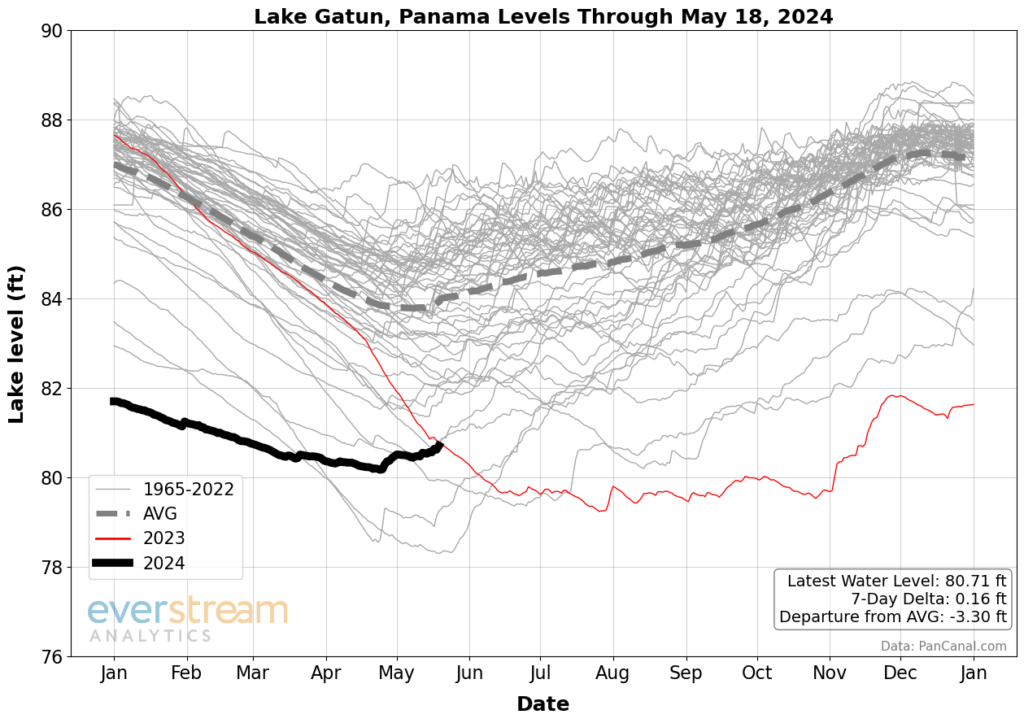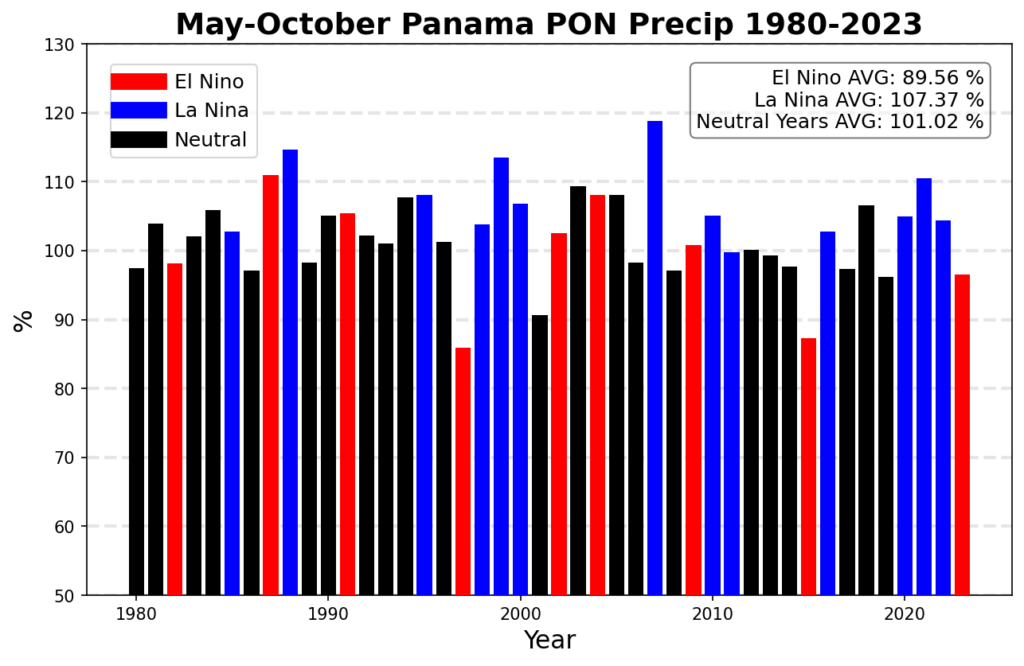Panama’s rainfall during the 2023 wet season was one of the lowest on record, triggering ongoing restrictions in both in vessel numbers and vessel weight. Restrictions create major disruptions for logistics moving through the U.S. Gulf and East Coast ports as 46% of container ship traffic between the Eastern U.S. and Northeast Asia travels through the Panama Canal.
Panama Canal restrictions increased in the fall as the water levels fell and have continued during the first part of this year. But that’s about to change with the onset of the wet season. Panama’s heaviest rains hit in July through September during the May-November wet season.
The current state of Panama Canal restrictions
Rain matters because the Panama Canal operates by taking fresh water from the interior lakes in Panama and using that to raise and lower ships through the intricate lock system. For each vessel traversing the canal, it takes an average of 50 million gallons (190 million liters) of fresh water. In normal times, around 15,000 ships traverse the Canal annually. Hence, it takes an extraordinary amount of water to allow the Canal to function properly, and fluctuations greatly disrupt supply chain logistics.
Lake Gatun is the largest and most important freshwater lake in Panama. Last year’s drought caused water levels to drop to the lowest ever recorded by July and remain at the lowest throughout the remainder of the year; the data goes back to 1965. This year started out with the lowest water levels of the past 59 years and has recently “improved” so that it is no longer the worst.
 Figure 1: Lake Gatun is still at historically low water levels, driving Panama Canal restrictions.
Figure 1: Lake Gatun is still at historically low water levels, driving Panama Canal restrictions.
Lake Gatun’s water level is still one of the lowest in the historical record and as a result, restrictions on shipping remain in place. The current level of Lake Gatun is in the process of crossing the level of last year on account of recent rain. Hence, the recovery, albeit from very low levels, has started.
The forecast for Panama Canal restrictions
Because Panama has a distinct wet/dry season, the only time of the year that can significantly impact the levels of the freshwater lakes is the wet season. Thus, rainfall during the next six months will determine whether lake levels improve or get worse. This in turn will determine the direction of future shipping restrictions – better or worse.
Prospects for the upcoming rainy season look much more favorable due to the transition from the El Niño to a La Niña event in the equatorial Pacific. Last year’s strong El Niño event suppressed rainfall in Panama as well as much of Central America as well as the northern portion of South America. Well below normal rainfall along with periods of unusual heat caused lake levels to remain low and not be replenished which is normally how things play out in Panama.
The cooler end of El Niño
The El Niño event (period of warmer than normal sea surface temperatures – SSTs – in the central and eastern sections of the equatorial Pacific), was in place during the final six months of last year and the first quarter of this year.
As of May, however, the event is done as SSTs have cooled and are no longer at El Niño levels. Everstream predicts a rapid transition to a La Niña event (period of cooler than normal SSTs in the central and eastern equatorial Pacific), which will continue to be in place through the end of the year.
This transition will provide a much more favorable environment for abundant rains during the core of the wet season this summer and into the fall.
 Figure 2: Rainfall, as a percentage of normal, for each year from 1980 to 2023 during the rainy season.
Figure 2: Rainfall, as a percentage of normal, for each year from 1980 to 2023 during the rainy season.
Last year’s rains were the fourth lowest in the past 43 years and followed three years of above-normal rainfall. To show the relationship of SSTs in the Pacific and rainfall in Panama, we have colored each year as to whether there was and El Niño, La Niña, or neutral conditions in place during the wet season.
The average rainfall during El Niño seasons is 89% of normal. The average rainfall during La Niña seasons is 107%. This relationship is not in place every year, but the vast majority of years follow these trends. Of the 13 La Niña years since 1980, only one of them (2011) had below-normal rainfall and that was only slightly below normal; 12 had above normal rainfall totals. Relatively small changes in rainfall bring disproportionate impacts to Panama – the Canal and the people.
The upcoming La Niña is projected to be moderate to strong and this further increases the odds of significant rainfall in Panama – already one of the worlds wettest places. Even normal rains during the upcoming wet season will substantially increase water levels in Lake Gatun and the other freshwater lakes. Above-normal rainfall will increase levels more quickly during the summer and fall.
The shift from El Niño last year to La Niña this year fundamentally changes the rain outlook during the upcoming rainy season in Panama. At the least, this will lessen restrictions (which has already started to occur).
The most likely scenario is for vessel restrictions to cease during the coming months.
The improved outlook will ease the Panama Canal restrictions that have plagued logistics since last summer. This will not occur overnight but with months of abundant rainfall, the levels of the freshwater lakes will rise to more normal levels – something that has not occurred for over a year.
LEARN HOW TO BALANCE LOGISTICS EFFICIENCY AND RESILIENCE IN OUR NEW WHITE PAPER: DOWNLOAD NOW
Jon Davis leads the Everstream Analytics weather and climate team as Chief Meteorologist. With over 35 years of experience, he is widely considered one of the foremost experts on the impact of weather and climate on global commodities and business.